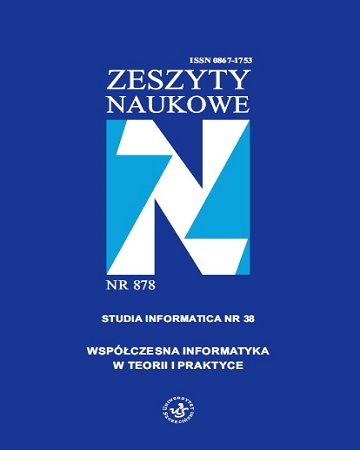
ISSN: 0867-1753
eISSN: 2300-410X
OAI
DOI: 10.18276/si.2015.38-04


Issue archive /
ZN 878 SI nr 38
Model gromadzenia danych monitorowania bezpieczeństwa informacji w organizacji wirtualnej
(Information security monitoring data retention model for virtual organizations)
| Authors: |
Tomasz
Klasa
Zachodniopomorski Uniwersytet Technologiczny w Szczecinie, Wydział Informatyki |
| Keywords: | information security security monitoring virtual organizations |
| Data publikacji całości: | 2015 |
| Page range: | 16 (49-64) |
Abstract
Information security monitoring in traditional organizations is quite a sophisticated process. In the case of virtual organization, however, it becomes even more difficult as its structure is very dynamic and borders flexible. This means that monitoring requires gathering and controlling status of numerous parameters, while list of them may change on a regular basis. As a result, although it is desired to gather and process data in-near-real-time mode, in practice it is not possible due to operational costs connected with such an activity. Gathering gigabytes of data from various sources may influence regular operation of organization’s basic services. Thus it is necessary to provide a mechanism of data acquisition that will reduce operational costs associated with gathering information security data from various remote sources.
Download file
Article file
Bibliography
| 1. | Aiello M., Pagani G.A. (2014), The Smart Grid’s Data Generating Potentials, „Annals of Computer Science and Information Systems”, vol. 2, s. 9–16. |
| 2. | Appel W., Behr R. (1998), Towards the theory of Virtual Organizations: A description of their formation and figure, „Newsletter”, no. 2. |
| 3. | Bean M.A. (2001), Probability: The Science of Uncertainty with Applications to Investments, Insurance, and Engineering, American Mathematical Society, Providence. |
| 4. | Brzozowski M. (2006), Ewolucja pojmowania wirtualności i definiowanie organizacji wirtualnej, w: Wybory strategiczne firm – nowe instrumenty analizy i wdrażania, red. P. Płoszajski, G. Bełza, Oficyna Wydawnicza Szkoły Głównej Handlowej, Warszawa. |
| 5. | Department of Defense (1999), Systems Engineering Fundamentals, Defense Systems Management College Press, Fort Belvoir. |
| 6. | IEC (1990), Fault Tree Analysis (FTA), International Technical Commission, IEC Standard, Publication 1025. |
| 7. | Muszyński J., Grimes R. (2011), Rozwiązania do zarządzania logami, NetWorld, http://www.networld.pl/artykuly/366992_1/Rozwiazania.do.zarzadzania.logami.html. |
| 8. | NASA (2002), Fault Tree Handbook with Aerospace Applications’, Version 1.1, NASA Publication. |
| 9. | SAP_MM, materiały szkoleniowe systemu SAP ECCv6.0, moduł MM. |
| 10. | SAP_PS, materiały szkoleniowe systemu SAP ECC 6.0, moduł PS. |
| 11. | Tanenbaum A.S. (2004), Sieci komputerowe, Helion, Gliwice |